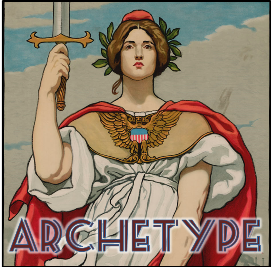 When I discussed the Hero archetype earlier, I pointed out that this character is the hub at the center of a wheel of other characters. In fact, in more subtle stories with lots of characters, that’s the best way to identify the Hero: figure out who has relationships to all the other characters.
When I discussed the Hero archetype earlier, I pointed out that this character is the hub at the center of a wheel of other characters. In fact, in more subtle stories with lots of characters, that’s the best way to identify the Hero: figure out who has relationships to all the other characters.
As the hub at the center of a web of relationships, the Hero can often seem hollowed out, having little character himself or herself. I would assert that this is because we are meant to project ourselves into the Hero to learn how to negotiate our own relationships with the real-world characters in our lives.
But, some fictional Heroes do seem to have individual character. Perhaps not early in the story, but as the story develops the Hero can often develop a rough and tragic character from the trials of the adventure.
What’s going on here?
I believe this is connected to the role of archetypes as an evolutionary tool for teaching the audience how to negotiate generational relationships. The Hero generation is the target of storytelling, young adults supposed to learn from the story how to relate not only to Villains, but also to younger Companions and older Roughs and even older Gurus.
The point is that people grow and, in this generational scheme, each archetype must grow into the next. Youthful Companions eventually must grow into Heroes, while Heroes have to grow into middle-aged Roughs and those Roughs have to grow into elder Gurus.
Need some examples? Let’s turn to my favorite narrative case studies.
RINGS, PIRATES, AND JEDI
In The Lord of the Rings, the Companion character Samwise Gamgee becomes more heroic through the story, the Hero character Frodo grows more rough, Aragorn grows more guru-ish, and the Guru Gandalf eventually becomes an ultra-Guru, so spiritual that he becomes the unreal White Wizard and ultimately has to leave Middle Earth.
If you’re familiar with the trilogy, the plot points I’m referencing will pop into your head. Sam starts out rather naïve, but he eventually saves Frodo from despair on Mount Doom by channeling Heroic energy. Frodo himself takes on a lot of Aragorn’s wounded warrior vibe as he suffers under the burden of the One Ring. Aragorn in turn reluctantly surrenders to his legacy as King of Gondor, pushing him into an elder role. Each generation grows into the next.
Similarly, in the original Pirates of the Caribbean trilogy, Elizabeth Swann eventually grows completely out of her Companion role and becomes the Hero of the final episode. Will Turner, who began the story as a rather generic Hero, becomes Roughed up through his troubled relationships to his father and Davy Jones. And Jack Sparrow eventually out-grows his roguish Rough ways to play a Guru role in the end, endorsing the rising Hero Elizabeth and sacrificing his own chance at eternal life in perfect Guru style so that Will can fulfill his Rough role as the ferryman for the dead.
Lastly, in the original Star Wars trilogy, the Companion character Lea develops in a Hero-ward direction over the course of the story, while the Hero Luke becomes so Roughed-up by the third episode that he’s tempted by anger toward the Dark Side, and the Rough character Han Solo becomes wiser over time to the verge of Guru status, a role he surrenders to completely by sacrificing his life in The Force Awakens.
CONCLUSION
In order to properly navigate the Big Four archetypes, one has to understand that they’re not static. As representatives of generational roles, they have to grow as human beings themselves grow. If you want to write powerfully with archetypes, you’ll tend to the growth of your characters from one generation to the next.
The Companion must grow up into a Hero, the Hero must grow Rough, the Rough must grow old as a Guru, and the Guru must grow beyond the world itself.
